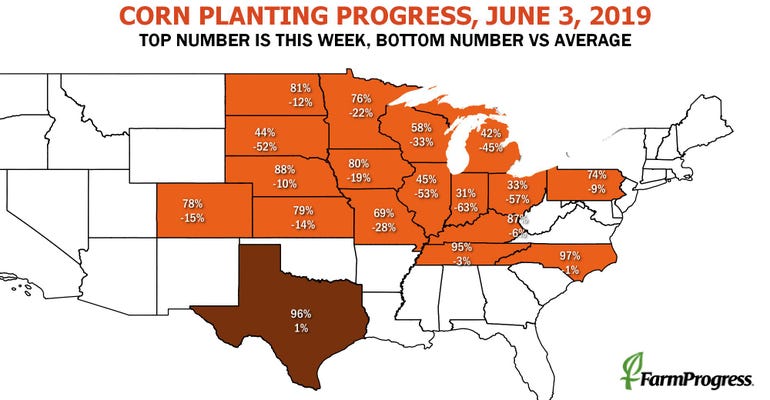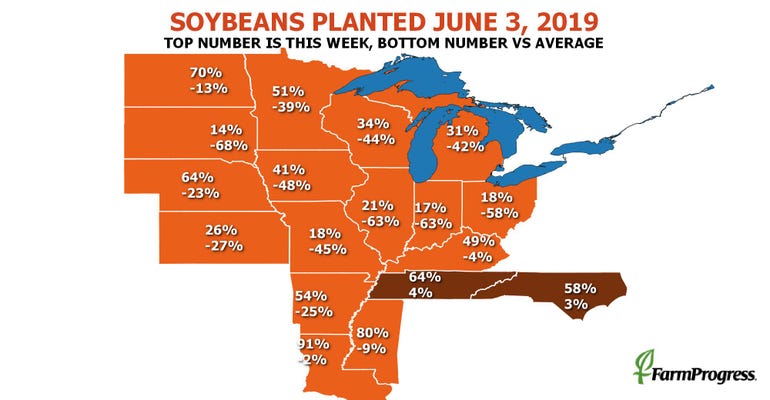USDA crop progress: Corn planting just two-thirds complete
Corn and soybean planting place continues to come in far below average.

With May in the books, another third of the 2019 U.S. corn crop has yet to be planted, according to the latest USDA crop progress report, out Monday afternoon.
“Today’s update from USDA came in on the lower side of estimates for corn and soybean planting, keeping both crops under the gun,” according to Farm Futures senior grain market analyst Bryce Knorr. “Only Texas was ahead of normal for corn planting, though growers in the western Corn Belt made better progress.”
Corn progress reached 67% as of June 2, up from 58% a week ago but still far behind 2018’s pace of 96% and the five-year average of 96%. Analysts expected a more robust pace of 71%, although trade guesses ranged between 68% and 76%. Five of the top 18 production states still haven’t reached the halfway mark, including Illinois (45%), Indiana (31%), Michigan (42%), North Dakota (33%) and South Dakota (44%).

Another 46% of the corn crop is now emerged compared to 32% a week ago, per USDA, versus 2018’s pace of 84% and the five-year average of 84%.
Deadlines pass Wednesday in much of the central Corn Belt for crop insurance, Knorr says. And for anyone wondering, 2019 is indeed a year for the record books, he adds.
“The previous record slow planting program for this week was 87% in 1981,” he says. “Wet forecasts for the next week, possibly two, aren’t encouraging for growers trying to decide whether to keep going, switch to soybeans or just take a prevent plant payment.��”
Soybean planting pace also continues to drag along, reaching 39% as of June 2 – up from 29% the prior week but well behind 2018’s pace of 86% and the five-year average of 79%. Analysts anticipated USDA would mark 42% of the crop planted this past week, with individual guesses ranging between 39% and 45%.
Of the top 18 production states, four have yet to even see progress reach 20%, including Indiana (17%), Missouri (18%), Ohio (18%) and South Dakota (14%).
Nineteen percent of this year’s soybean crop is now emerged, versus 11% a week ago. 2018’s pace was 65%, with a five-year average of 56%.
This year’s pace is also one for the record books, Knorr notes – the previous slowest pace was in 1995, when 43% of the crop was planted by early June.

Spring wheat planting progress is nearly caught up to prior years, meantime, reaching 93% complete last week – versus 96% for the five-year average. Of that, 69% of the crop is now emerged. The crop is also in relatively good condition, with USDA rating 83% in good-to-excellent condition, versus 70% last year.

Winter wheat crop condition held mostly steady, against analyst expectations. For this past week, 64% was rated in good-to-excellent condition, with 27% rated fair and the final 9% rated poor or very poor. Analysts estimated USDA would drop quality ratings to 59% in good-to-excellent condition.

Physiologically, 76% of the U.S. winter wheat crop is now headed, up from 66% the prior week but still moderately behind 2018’s pace of 82% and the five-year average of 84%.
“The news about wheat was markedly different,” Knorr says. “After dropping last week, ratings for winter wheat rebounded. But gains came for white and hard red winter wheat, because the SRW crop to the east declined, hurt by excessive rains that also were a problem in Oklahoma.”

For spring wheat crop quality, USDA surprised the trade with a very strong initial rating for the crop, Knorr says. If these ratings hold, it suggests all-wheat production could be about 75 million bushels better that USDA forecast May 10, he says.
Other crop progress of note include:
Barley – 94% planted (versus 84% the prior week)
Rice – 91% planted (versus 84% the prior week)
Sugarbeets – 97% planted (versus 94% the prior week)
Peanuts – 86% planted (versus 79% the prior week)
Sorghum – 35% planted (versus 28% the prior week)
Cotton – 71% planted (versus 57% the prior week)
About the Author(s)
You May Also Like


.png?width=300&auto=webp&quality=80&disable=upscale)


